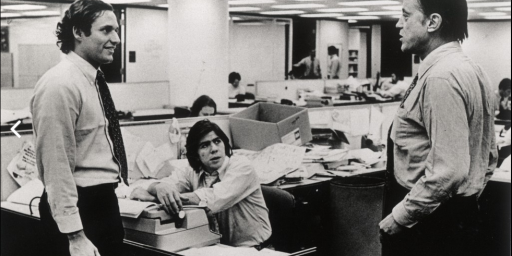Journalistic Force Multipliers
Slate’s Jack Shafer argues that journalists’ cries about cuts in the news budgets dire impact on our democracy miss some fundamental changes in technology:
The idea that a newsroom should employ X hundred staffers because it has traditionally employed X hundred staffers ignores the changes technology has made in the news market. For instance, Tribune critics denounce it for cutting the foreign bureaus at the Baltimore Sun and Newsday, which it owns. But should every metropolitan newspaper keep its Moscow or Jerusalem bureaus when readers can click to Web coverage from the New York Times and the international press, especially when many of those papers are losing circulation? Something’s got to give.
Likewise, journalists don’t want you to know this, but thanks to technology, it’s never been easier to hunt down a story, capture it, and bring it back to the presses for printing. A middle-school student sitting at a Web terminal has more raw reportorial power at his fingertips than the best reporter working at the New York Times had in, say, 1975. The teenager can’t command an undersecretary of defense to return his phone call as the Times guy can, but thanks to Google he can harvest news stories and background information that would take the 1975 model journalist days to collect.
The young amateur can also tap hundreds of free databases serving up scientific, legislative, regulatory, and business information in an afternoon that a team of 1975 reporters couldn’t assemble in a week. Give him access to JSTOR, PubMed, Edgar, Nexis, Factiva, and other important sites and he’ll write three stories in the time the ’70s veteran reports one. Naturally, the kid might not have as good an idea of what to do with the information he’s collected, but you get my point: Technology has made today’s reporter more productive and more accurate than his forebears. So, if the Los Angeles Times peaked at 1,200 reporters and it’s down to about 940 now and Tribune wants to cut it further, it’s hardly proof that the corporate meanies are defunding the newsroom.
Quite true.






I’d argue that the more foreign correspondents who exist within the realm of journalists, the better the nation–as well as the newspapers–are served.
Leaving foreign reporting to a handful of “biggies” means limiting perspectives to a handful of people. Some of the best foreign reporting I’ve seen has come from papers like The Hartford Courant. I already know how the NYT and WaPo will report an incident, how close to the facts they care to get. With one reporter responsible for a half-dozen or more reporters, there will be okay coverage of one or two countries, then a hash on everything else.
In my dealings with the reporters from the big papers and networks, it was always a matter of providing data to support the pre-conceived story. Those from small papers were usually a surprise.
Not all NYT or WaPo foreign correspondents are junk, just most of them.
The one qualitative advantage the newspapers have is in getting the story. Blogs are much better at context and analysis (which is in part because of the stuff the middle schooler example points out), but not as good at getting the original reporting. I think they have the potential in the future for improving on this, but not yet.
So when a newspaper takes its top assets (reporters who presumably are gathering the news) and reduces it, they are cutting into their advantage. The more they reduce themselves, the more they tend to rely on the “press release” story. And there, the blogs can be just as good.
I would suggest that they work on becoming a more trustworthy news source. The paper that can produce the most accurate, unslanted report on what is going on will have a huge advantage as the internet age unfolds.
And yet, as Brad DeLong shows over & over, journalists ignore the wealth of data at their fingertips, in favor of writing down whatever the gov’t tells them and getting an “oppo quote” for the next-to-last graf on page A15.
Quality, not quantity, of journalists is the problem.
Yer gonna miss us when we’re gone …
Don, we don’t want you “gone”, we just wish your profession would do its fricking job! Instead, it’s a combination of overtaxed reporters doing half-assed jobs.
The overtaxed part isn’t your fault–but where oh where is that journalists’ union? The half-assed and lazy part is your (collective) fault. The total lack of introspection on the part of journalists is only typical for the age, I guess, but it’s one of the major reasons that traditional journalism is dying an ugly death.
Instead of J-school grads trying to “save the world,” they could start by trying to save their souls. And I mean that in a humanistic, not a religious sense.
Do their job is right, John. The New York Times just ran an article on whether or not Joe Lieberman ever used the ‘stay the course’ phrase. After an exhaustive search of their database they confidently reported that no such phrase was ever uttered by the good Senator.
The apology is now online. Nexis, Factiva, pubmed and all the rest are amazing tools, but you have to use them. Sorry, let me rephrase that- you need to want to use them.
Like the NYT story on the White House’s burial of the “stay the course” slogan, which somehow failed to even mention Bush’s “it’s never been ‘stay the course'” remark over the weekend. I guess the White House left that out of the press release.